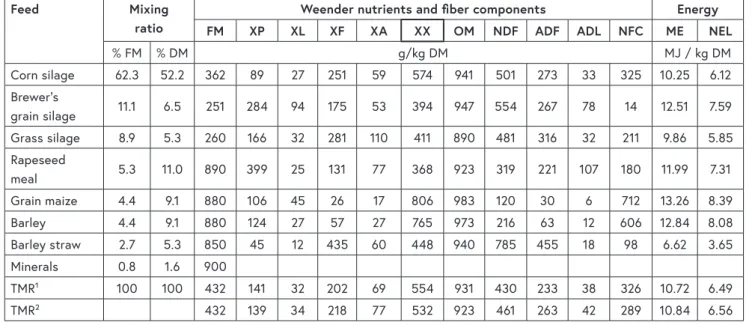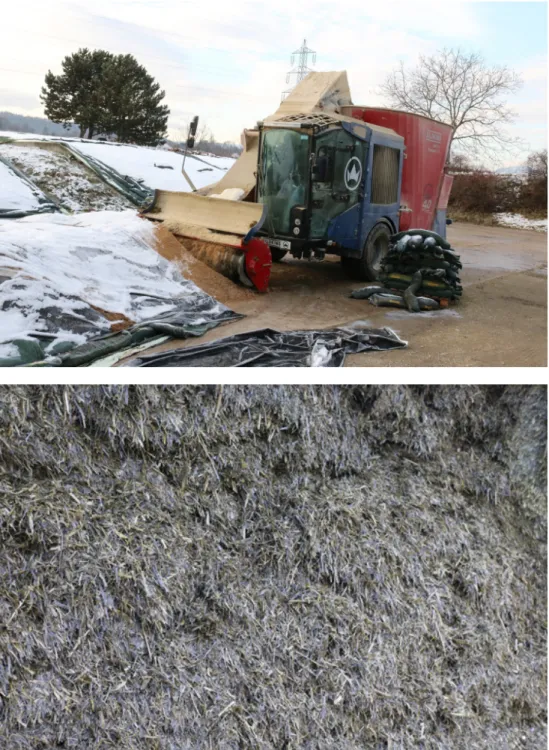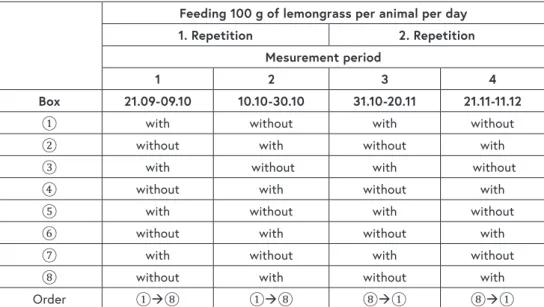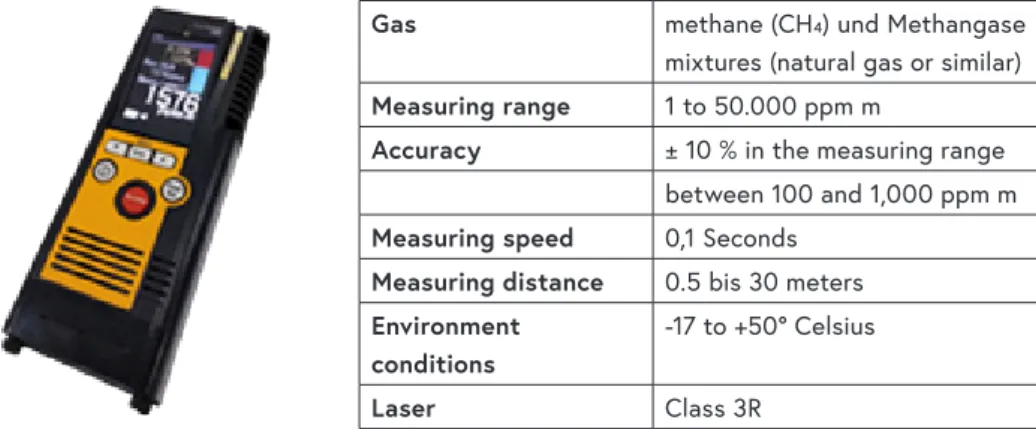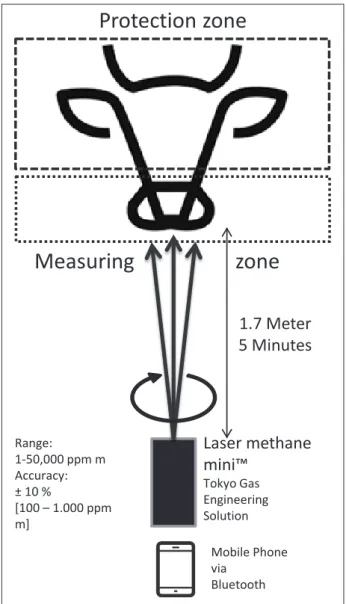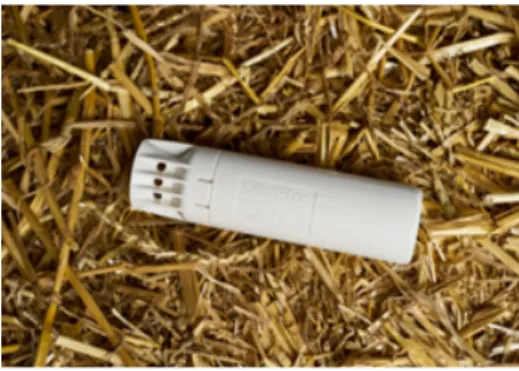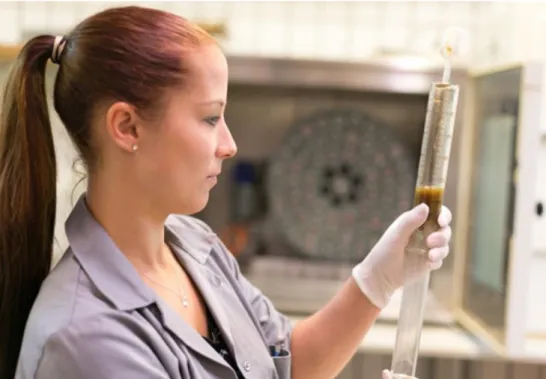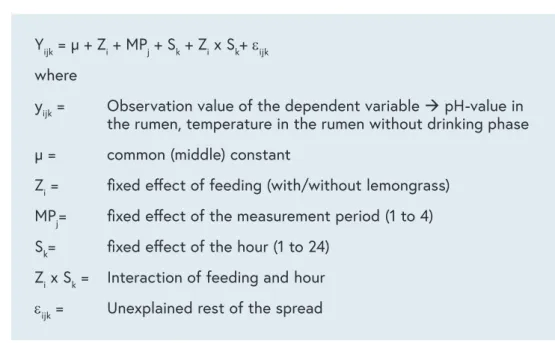Biogenic CH4 is a low-density odorless gas that causes no harm in the immediate environment of the animal. This is possible by increasing the proportion of maize silage and/or concentrated feed in the ration, or by improving the quality of the feed (JAYASUNDARA et al. 2016, BEAUCHEMIN et al. 2020). The microbial composition and digestive processes in the rumen can be influenced either by vaccination of the host animal and defaunation (removal of protozoa from the rumen) or by the use of feed additives (BRADE and DISTL 2015b).
These include, for example, natural rumen metabolic products (e.g. propionate), as well as inorganic feed additives such as nitrate (BEAUCHEMIN et al. 2020). However, feeding the legumes with the highest tannin content resulted in a very significant reduction in ration digestibility. Only the neutral detergent fiber (NDF) digestibility of the feed decreased significantly (STAERFL et al. 2012).
The fattening capacity of beef cattle is on average 1300 grams per animal per day over several years (Figure 1). In the last two rows of Table 1, the added scores of the individual components are compared with the averages of the mixed samples. The ration in this trial differs greatly in the composition of individual ingredients from the prescribed reference ration.
This measure ensures that a possible impact of the measurement duration of individual animals can be balanced in the overall trial.
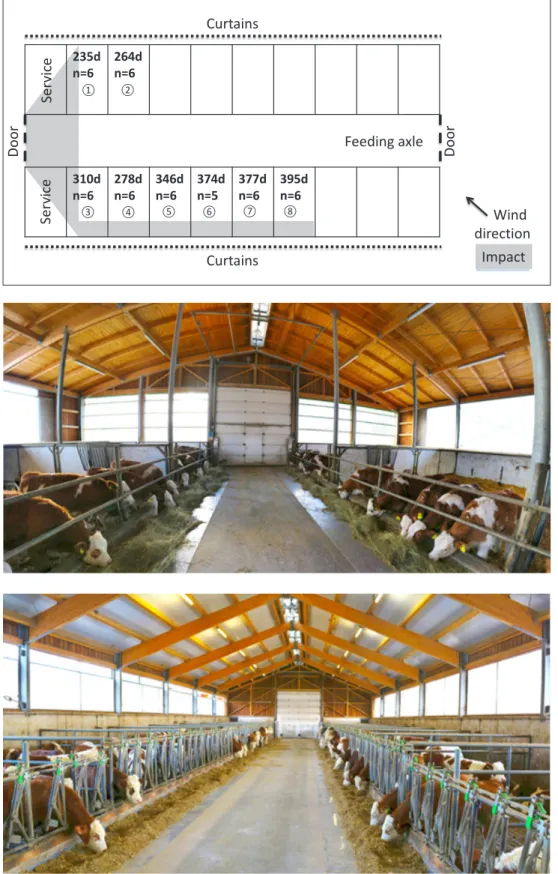
Meter 5 Minutes
The reasons for the variability are the natural breathing cycle of the animals, the emission dynamics of the rumen, the measuring atmosphere, the measurement and the test question. The skewness and curvature deviate significantly from the normal distribution. Therefore, an angular transformation must be performed for the group comparison of the entire data set. To investigate the local effect of the test question within the variability of the measurement, each animal's data set was transformed into relevant amounts of descriptive statistics.
Colonization of the rumen with bacteria and protozoa is a natural process that is closely related to the food supply. Of the different species that specialize in different food components, the necessary species are always available. If we interfere with this natural structure with food additives, we must be aware that we can also interfere with natural processes.
The possible influence of the addition of lemongrass on the conditions in the rumen is investigated in the field trial by using measuring boluses from smaXtec. From there, the boluses slide into the rumen, where they remain in the reticulate stomach due to their weight. The data from the smatec boluses is continuously sent via radio link to the company's data service and can be read from there in edited form via a dashboard.
This access to your own data is a real service for scientific experiments, because possible effects can be tested in real time and collecting the data is very easy. The entry of the boluses took place somewhat late in the current first measurement period, because a new generation of technology was used for this research. In the remaining samples, a sliding transition between the HFT hay stand and the lemongrass was examined.
The check for normal distribution of the CH4 values showed a right-skewed data position, which was corrected by an angular transformation. Zi = fixed effect of nutrition (with/without lemongrass) MPj = fixed effect of the measurement period (1 to 4) Zi x MPj = Interaction between nutrition and measurement period εij = Unexplained remainder of the distribution. Zi = fixed effect of nutrition (with/without lemongrass) MPj= fixed effect of the measurement period (1 to 4) Sk= fixed effect of the hour (1 to 24).
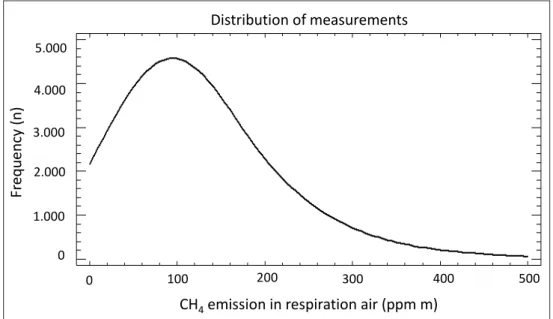
Results
A constant amount of 100 g of lemongrass is diluted during the study, as shown in Table 4, due to the ever-increasing feed intake of the individual groups. If 100 g of lemongrass at the beginning of the experiment in the youngest group represents 1.70% of the ration, this value will decrease to 1.14% at the last measurement period. The application of the described statistical model with the two classes of feeding and measurement period leads to the results in table 5.
In the group without lemons, a higher level is reached with the range from 69.1 to 322.5 ppm m for all parameters. Influence of the measurement period: The conditions required for the description of the measurement period cannot be consistently observed in the field test. A bad spell of strong northerly winds in the last week of October and lower daytime temperatures in December meant that the rolling shutters were not always equally open and therefore the overall concentration in the fattening barn varied between measurement periods.
In particular, the situation in the second measurement period meant that these generally varied considerably. This realization confirms that all measurements within the measurement session must be carried out in the shortest possible time. Interaction between feeding groups and measurement period: The interaction of the two classes was not significant.
Effect of feeding with 100 g lemongrass and measurement date on CH4 emissions in the breathing air of beef cattle. Therefore, the temperature in the rumen remains constant during this period, but the pH rises slowly because the added saliva buffers the acids. In the morning and evening hours, driven by the feeding cycles and the feeding template, two peaks result in the parameter activity and water intake.
The temperature in the rumen does not follow the feeding cycle, but the body temperature of the cattle. The graphs in the figures below show that the differences between the feed groups were indeed sometimes only marginal. This result, although only carried out as a touch test, confirms statements about the effect of large amounts of tannin on the microbes in the ruminant.
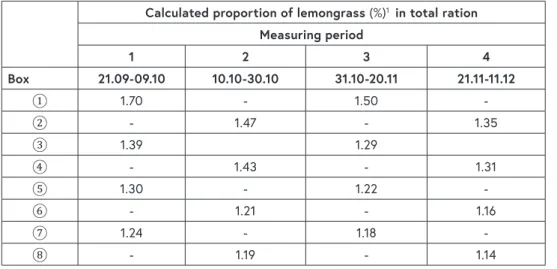
Summary and discussion
For the field trial, 47 beef bulls weighing between 300 and 600 kg were selected in 8 stables of 6(5) animals each. At the end of each measurement period, the CH4 content in the breath of each animal was measured using the Laser Methane mini (LMm) device from Tokyo Gas Engineering Solution. The absolute results of these measurements are highly dependent on the environmental conditions in the stable and the technology used.
These measuring sensors provide continuous information about the pH value and temperature in the rumen. In this test, gas formation was monitored at different amounts of lemongrass in the sample. In the period between September and December 2020, all planned measurement data were successfully collected and statistically evaluated.
The results of each measurement of CH4 with LMm, which shows the CH4 concentration in the breath, were tested not only as a mean value, but at 5%. It turned out that an addition of 100 grams of lemongrass per animals per day reduced the CH4 concentration in the breath over the entire spectrum. The effect on the quartiles varied from 18.7% in the first quartile to 12.7% in the fourth quartile.
On average, the addition of 100 grams of lemon grass reduced the concentration of CH4 in the breath by 14.6%. This is probably due to the high content of condensed tannins in lemon grass and reduced degradation of fiber components by ruminants (GOEL and MAKKAR 2012). Since methane is produced in the rumen during the degradation of fiber components, this results in the methane-reducing effect of lemon.
The desired effect can be clearly defined and the wide use of high-tannin feed can be recommended when: a.) the reduction effect is consistently confirmed throughout the fattening period and b.) a general decrease in fiber digestibility - rich rations remain low. The central parameter of the daily fluctuation of pH and temperature in the rumen is time in the constant dynamics of eating, chewing and digestion. The smaXtec rumen sensor is a really good device for observing processes in the rumen and is recommended for use by practitioners and other research groups.
Research to be done
The statistical evaluation of the measurements of the smaXtec measuring boluses showed only marginal differences when adding 100 grams of lemongrass per animal per day. It can be assumed that the addition of this small amount does not reduce the digestibility of the manure ration with an energy content of 10.8 MJ ME/kg DM, a crude protein content of 139 g/kg DM and a crude fiber content of 218 g. /kg DM. The hours of the statistical evaluation reflect the course of these dynamics as well as the activity of the animals and water intake.
Thanks
WAG-NER-RIDDLE, 2016: Methane and nitrous oxide emissions from Canadian dairy farms and mitigation options: an updated overview. HOSTE, 2020: In vitro rumen fermentation of diets containing different types of condensed tannins derived from samphire (Onobrychis viciifolia Scop.) pellets and hazelnut (Corylus avellana L.) pericarps. SODER, 2020: Ruminal fermentation and enteric methane production of legumes containing condensed tannins fed in continuous culture.
SWALEA, 2017: The agreement between two next-generation laser methane detectors and respiration chamber facilities to record methane concentrations in the spent air produced by dairy cows. PSZCZOLA, 2018: Comparison of a laser methane detector with GreenFeed and two breath analyzers for on-farm measurements of methane emissions from dairy cows. SOLIVA, 2012: The methane conversion rate of bulls fattened on grass or maize silage compared to IPCC standard values and the long-term methane mitigation effectiveness of adding acacia tannin, garlic, maca and lupine.
Final report Lemongrass
